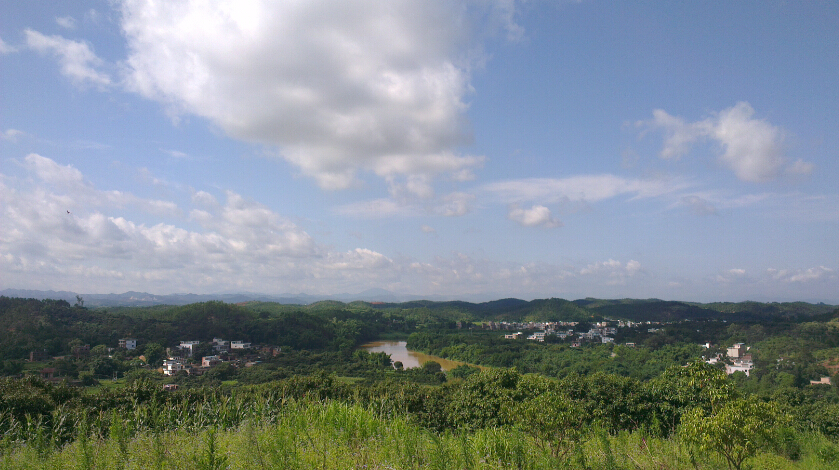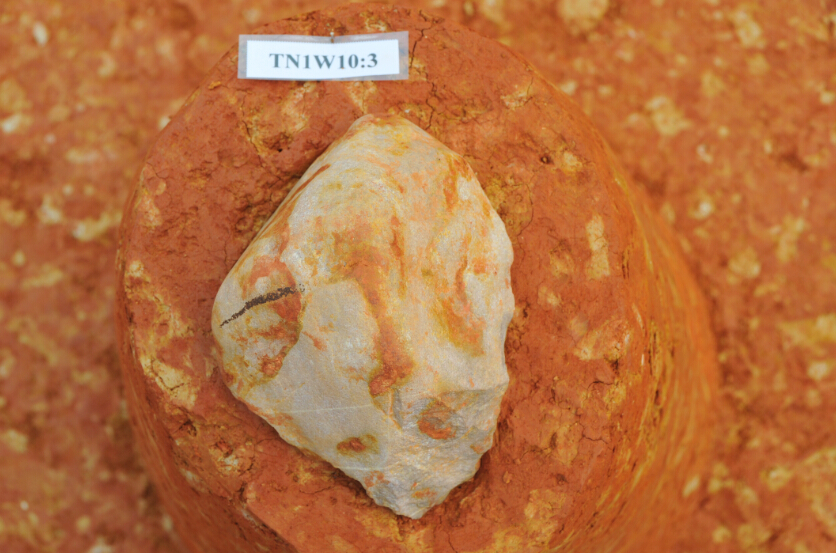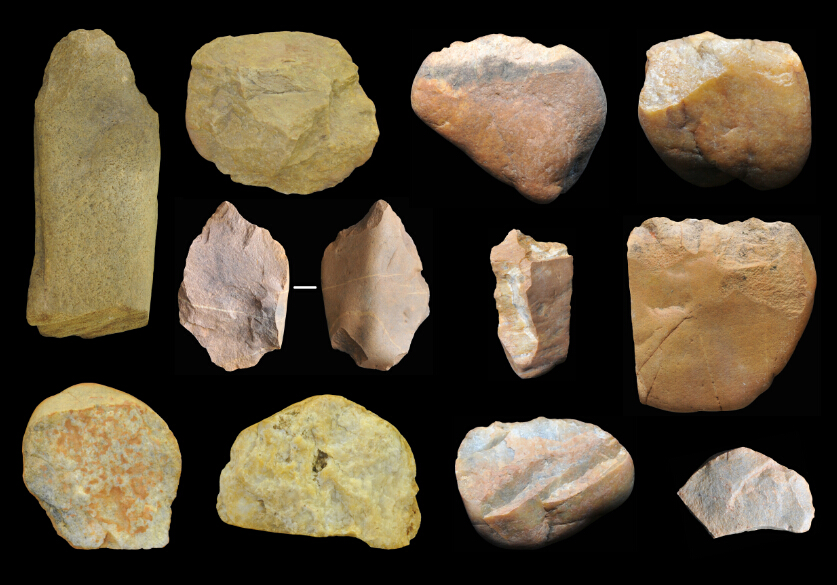The Palaeolithic Archaeological Discoveries in Guangdong Province That Fills Up the Gap of Ancient Nanyue Culture
From:Chinese Archaeology NetWriter:Date:2015-04-10
The new discoveries of more than 60 Palaeolithic sites at Modaoshan Hill and Nanjiang River Basin have clearly revealed the ancient habitat pattern that created by subtropical-tropical climatic environments of Lingnan region, as well as the Palaeolithic cultural sequence. The evidence has further shown the early human stone productions and other living activities at low latitudes of Southeast Asia, which provides significant new information for the archaeological investigations of Palaeolithic China and also is very important to the further study of ancient human activities, adaptions, and local hominid evolution in south China and Southeast Asia.

the enviroment of Nanjiang River basin
Modaoshan site is located in Hedu village, Hekou town, Yunan county, Guangdong province. It is situated at northeast part of Nanjiang basin, which is the fourth terrace on the west bank of Nanjiang River. The rescue excavation of location I of Modaoshan site was carried out by Guangdong Provincial Institute of Culture Relics and Archaeology, School of Archaeology and Museology Peking University, Museum of Yunfu City, and Museum of Yunan museum together. The total excavation area is 200 square meters. There are two early Palaeolithic cultural layers with stone artifacts found on the reticulate red clay deposit. About 400 different kinds of stone productions have been unearthed, that confirmed the main activity area used by early hominids at this site is more than 1000 square meters.
According to the local geological research results, the absolute age of sediments of the fourth terrace at Nanjiang River’s main stream Xijiang is between 800,000 to 600,000 BP. On the other hand, based on the stone artifacts found at the site, the site is in early Palaeolithic period and the absolute age is same as that in the fourth terrace.

artifacts distribution of early Palaeolithic cultural layer at Modaoshan site
About 400 stone artifacts including stone materials, stone cores, flakes, broken pieces, stone hammers, flints, broken flints, gravels and stone tools have been found during the excavation, where the quantities of stone materials, flakes, broken pieces, stones cores, and gravels are in majority, and stone tools are comparatively rare. The raw materials used were mainly sandstone, quartz, and quartzite. The types of stone productions found cover the whole process of transport, in-process, use, and abandon, which reveal the complete stone production chain at the site. Therefore, the site is the primary burial position of these stone artifacts found.
The stone artifacts are always made by shaping gravels. The processing technology is mainly through hammering single side, which is very simple and rough. The blade is generally unsmooth and the edge is commonly with a shape of serration. The types of stone tools include chopper, handpick, hand axe, and scrapers, where the quantity of chopper is the largest among them. There are mainly large and middle sized stone tools. In addition, it is common to use gravels directly as tools. The lithic technology at Modaoshan site has the general characteristics of gravels tools industries in south China.

unearthed handpick in Modaoshan site
According to the distribution of the site, the main activity area of early hominids at the time was much more than 1000 square meters. At the same time, the unearthed stone artifacts indicate the complete production chain of stone tools. Therefore, the location I of Modaoshan site is one of the main central camps used by early hominids at both sides of Nanjiang river during the early Middle Pleistocene.
Later, the Palaeolithic archaeological regional surveys are carried out in the Nanjiang River region by Guangdong Provincial Institute of Cultural Relics and Archaeology, Museum of Yunfu City, Museum of Yunan County, and Museum of Luoding City together. Until now, the field surveys have firstly found open-air Palaeolithic group sites. There are 66 Palaeolithic sites found in the Nanjiang River region, with hundreds of chipped stone tools such as choppers, handpicks, hand axes, scrapers, points, and un-edged tools. The main location of the group sites is at northeast part of the Nanjiang Basin, distributed in a 20 square kilometers range at Hekou town and Dawan town in Yunan county. The lithics sites are found between the second terrace and fourth terrace of both sides of Nan River.
The surveys and experimental excavations of the location IV of Modaoshan site, Luogending, and Dongshuikou location in 2014 have confirmed the stratigraphy of unearthed stone tools in the different locations. The Palaeolithic group sites of Nanjiang River cover the periods from middle to late Pleistocene and reveal the characteristics of different periods.

unearthed stone artifacts from late period at Modaoshan site
The dense distribution of Palaeolithic sites in the Nanjiang River Basin region is relatively rare in south China and Southeast Asia, which clearly shows the information as ancient habitat pattern of early hominids in the region. The dense distribution of Palaeolithic sites also indicates the frequent and long-term human activities in the Nanjiang River region during the Pleistocene period. The large quantity and various types of stone artifacts and large human activity areas found from the location I of Modaoshan site confirmed the completely stone production chain and its function as a base camp. Luokending site is similar to it. However, the relatively small quantities and unitary types of stone tools and small-distributed ranges of the location IV of Modaoshan site, Dongshuikou, Mulinan, and Dapengshan sites show the characteristics of temporary activity areas.
The difference in the quantities of stone productions and functions of different sites along the Nanjiang River region reveal the ancient habitat pattern of the base camp and temporary activity areas during the Pleistocene period, which also closely related to the subtropical-tropical climatic environment and the adaptability of early hominids.
The excavation of the location I of Modaoshan site reveals the distribution of stone productions, early hominids activity areas, lithic production chain, and the adaptability of early hominids in the low latitudes regions for the first time, which hence indicates the lithic productions and adaption pattern of early hominids in the south to the tropic of cancer. Also, it clearly presents the connections and differences of the early human activities during the Palaeolithic period between subtropical and tropical areas, north part of south China, south of the Five Ridges, and Southeast Asia. (Translator: Li Xuelei)

